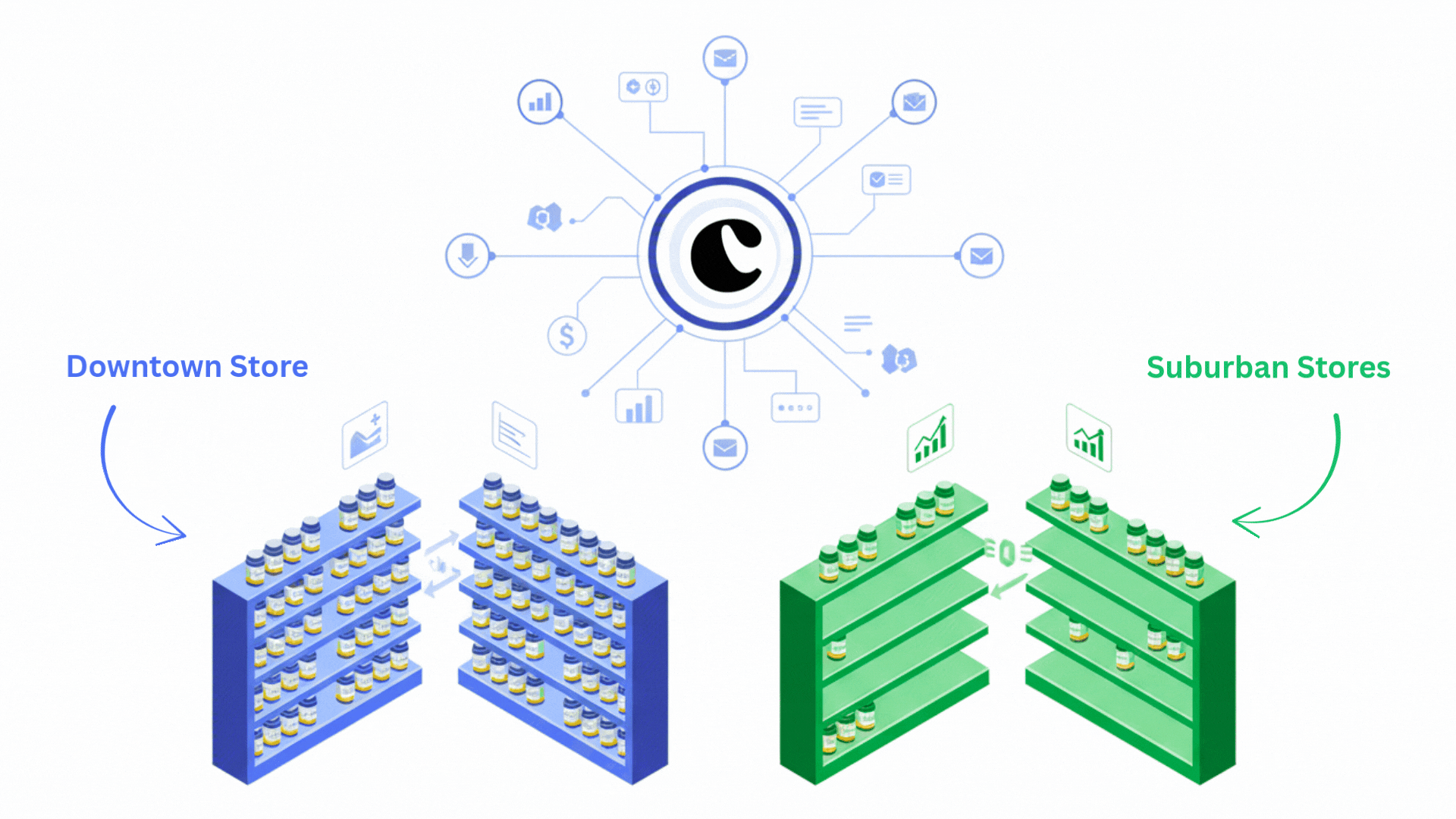A major pharmacy chain discovered its downtown locations were losing $50,000 monthly on overstock vitamins while suburban stores constantly ran out of the same products. Same corporate buying strategy. Same distribution model. Different neighborhoods with completely different health and wellness priorities.
This inventory mismatch costs retailers millions annually. The era of identical inventory across all locations is over - customer expectations and competitive pressure have made hyperlocal planning a business essential.
In fact, a 2023 industry report estimates global inventory distortion (overstocks + out-of-stocks) at about US$1.77 trillion, underlining the scale of losses from one-size-fits-all inventory strategies.
Traditional inventory systems can't handle this complexity. They treat all locations like identical units in a spreadsheet.
But walk through any major city and you'll see the reality:- Peak shopping hours vary dramatically by location
- Product preferences change street by street
- Seasonal patterns follow local rhythms, not corporate calendars
- Economic factors impact spending differently across neighborhoods
- 7-Eleven Japan demonstrates hyperlocal mastery. Each location customizes its inventory based on community demand patterns. Office district stores prioritize ready-to-eat meals and beverages for lunch crowds. Suburban locations focus on household essentials and family-oriented products.
- Tesco Express uses demographic intelligence across UK markets. They adjust product mix and pricing using local demand signals and customer data. Affluent London neighborhoods see different product selections and promotions compared to student-heavy areas.
- Carrefour City shows how AI drives daily inventory decisions. French urban locations use predictive analytics to adjust fresh food, bakery, and convenience assortments based on foot traffic patterns, weather data, and local events. They also deploy dynamic markdown pricing on perishables to reduce waste.
- Whole Foods Market customizes its selection by regional preferences and demographics. Seattle locations emphasize sustainable seafood and organic produce. Austin stores feature locally-sourced Texas products. Following the Amazon acquisition, they've tested hyperlocal pricing tied to Prime membership benefits.
- Circle K optimizes across diverse North American locations. Their system considers local demand trends, traffic density, and competitive pricing for location-specific inventory and pricing decisions. Highway locations dynamically adjust snack, beverage, and fuel pricing based on regional demand patterns.
Modern local demand forecasting systems process dozens of data streams that traditional methods ignore completely.
- Customer Traffic Analysis: AI tracks when people visit, how long they stay, and what triggers purchases. A subway station store sees different patterns than a residential area location. These rhythms determine optimal product availability windows.
- Competitive Intelligence: Real-time monitoring of competitor pricing, promotions, and stock levels. When the store across the street runs a beverage promotion, smart systems automatically adjust inventory expectations.
- Demographic Shifts: New apartment buildings, office developments, and school changes impact demand months before sales data reflects it. AI spots these trends early and adjusts planning accordingly.
- Local Event Impact: Construction projects, festivals, sports events, and seasonal activities create demand spikes that generic planning completely misses.
This comprehensive approach delivers measurable results in many test cases and pilots:- ~25-35% reduction in overstock situations
- ~25-40% fewer stockouts on popular or high-velocity items
- ~20-30% improvement in inventory turnover rates
Want to see hyperlocal inventory optimization in action? Schedule a free consultation with Couture.ai and discover how AI can elevate your inventory performance across every location.
Traditional inventory planning is educated guessing. You look at last year's sales, add some buffer, and hope for the best. AI inventory tailoring eliminates assumptions.
- Predictive Stockout Prevention: Advanced systems identify potential stockouts 3-7 days before they happen. This gives time to transfer inventory between locations, adjust delivery schedules, or promote substitute products.
- Overstock Management: Before slow-moving inventory becomes a problem, AI suggests pricing adjustments, inter-store transfers, or promotion opportunities. Products move efficiently without margin-destroying clearances.
- Seasonal Transition Optimization: Different neighborhoods adopt seasonal products at different speeds. Some areas embrace fall items in August. Others wait until October. AI times these transitions perfectly for each location.
- New Product Launch Strategy: When introducing new items, AI predicts which locations will see early adoption versus late adoption. This prevents equal distribution, which leaves some stores overstocked while others miss sales.
Decision makers implementing hyperlocal inventory planning should expect a comprehensive business transformation:
Financial Impact- 20-30% reduction in total inventory costs through precise demand matching
- 15-25% increase in gross margins via reduced markdowns and better sell-through
- Improved cash flow from faster inventory turns and reduced capital tie-up
- Higher sales per square foot through better product mix optimization
The Inventory Management Report also highlighted how poorly timed central buying caused a 16% surge in inventory investment without matching sales gains, reinforcing why AI-tailored stock allocation is essential for margin protection.
Operational Benefits- Automated planning processes reduce manual workload by 40-60%
- Faster response to market changes through real-time data processing
- Better supplier relationships via more accurate demand forecasting
- Scalable growth model maintaining efficiency as you add locations
Strategic Advantages- Market differentiation through superior product availability
- Customer retention improvement of 15-25% due to better service levels
- Competitive positioning that's difficult for others to replicate quickly
- Future-proof business model that adapts automatically to market changes
The compound effect creates sustainable competitive advantage.
Every neighborhood tells its own story through purchasing patterns. AI helps you read those stories and stock accordingly. The result is better margins, happier customers, and sustainable growth across all markets.
Ready to see how hyperlocal planning can improve your inventory performance? Contact Couture.ai today and explore how AI can optimize your stock management strategy for maximum profitability across every location.
Explore solutions that will revolutionize:
Stay Ahead with AI Insights.
Subscribe to get the latest updates and trends in AI, automation, and intelligent solutions — directly in your inbox.
